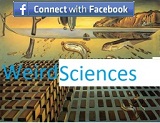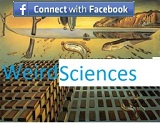Latest Experiment Proved:Time Travel Is Possible
 |
GRAVITY CONTROL AND WARP DRIVE FOR SPACE TRAVEL GENERAL RELATIVITY THEORY AND APPLICATIONS … GRAVITATIONAL WARP DRIVE FOR SPACE TRAVEL … GRAVITY AND CURVATURE OF SPACETIME … TEST FOR FLATNESS OF SPACETIME … HOW TO DETERMINE, E = MC2 … SPACETIME CURVATURE … RESULTS TO DATE … Copyright © 1999-2010 John Cipolla/AeroRocket. All rights reserved |
(1) GRAVITATIONAL WARP DRIVE FOR SPACE TRAVEL John Cipolla is performing ground breaking research in the area of gravitational warp drive technology and gravity control for faster than light star travel. The illustrations below show a spacecraft being accelerated while enclosed within an artificially generated warp bubble. The following results from the theory of General Relativity illustrate how a warp bubble uses opposing regions of expanding and contracting spacetime for propelling a starship at velocities exceeding the speed of light. This is a work in progress based on a new method for warping spacetime to generate warp bubble disturbances without the need for exotic matter or negative energy. Experiments are being conducted to evaluate the method’s capability for generating the theoretical warp metrics depicted in Figure-2, Figure-3 and Figure-4. |

Figure-1: Warp bubble traveling adjacent to the Earth (not to scale)

Figure-2: Warp bubble geometry illustrating how spacetime compression and expansion
propel a warp bubble and an enclosed starship through space to distant stars


Figure-3 and Figure-4: Warp metrics generated using “new” methods
Starship is located on the flat part of a warp bubble disturbance
RESULTS TO DATE
MATHCAD WARP DRIVE ANALYSIS (10/15/2008)

_metric.gif)

Figure-5, Figure-6 and Figure-7: Theoretical warp metric derivation using MathCAD
| MathCAD results for the Relativistic analysis of the Alcubierre faster than light warp metric is illustrated in the above contour plots. Figure-5 represents a light cone where rs(t) = [(x-xs(t))2 + y2 + z2]1/2. Figure-6 represents the metric-shape function, f(rs) also called the “top hat” function and Figure-7 displays the resulting spacetime warp metric for faster than light space travel. |
WARP METRIC TEST RESULTS (2/12/2009)



Figure-8, Figure-9 and Figure-10: Experimental and theoretical warp metrics
| These results compare the energy signature of a new method to warp spacetime shown in Figure-8 to the theoreticalAlcubierre warp metric displayed in Figure-9 and Figure-10. Work continues using a laser to map spacetime around the experimental warp metric and clocks to measure time dilation within and around the proposed warp bubble. |
LASER SPACETIME WARP EXPERIMENT (4/14/2009)

Figure-11: Laser spacetime warp experiment
| Laser experiment used to map spacetime around the proposed warp drive demonstration device. This laser measurement system is mechanically and acoustically isolated from the system used to warp spacetime. Similar experiments are being designed using synchronized clocks to measure time dilation effects. No positive results to date. |
LASER SPACETIME WARP EXPERIMENT (8/12/2009)

Figure-12: Laser spacetime warp experiment using fog
| The same experiment using a fog machine to trace a laser beam around the warp bubble disturbance. The laser beam was not deflected indicating spacetime is not being warped to any measurable degree by the proposed warp generator. Several configurations of the warp generator resulted in the same null result. The experiments are continuing using conventional energy sources to affect spacetime… |
WARP METRIC RESULTS (02/15/2010)
![]()
Matter-energy tells spacetime how to curve and spacetime tells matter-energy how to move
| SPECIAL NOTE: The aim of these experiments was an attempt to show that a warp bubble could be generated using electromagnetic energy instead of negative energy as required by Alcubierre’s faster than light warp metric. The method proposed to warp spacetime seems to match the signature warp bubble theoretically predicted using negative energy. General Relativity, Dark Matter and Dark Energy cosmology indicate that a warp bubble is analogous to expanding spacetime observed to occur between distant galaxies. In effect, expanding spacetime between galaxies is like a conveyer belt pushing galaxies apart at a rate of approximately 71 km/sec/mega parsec. While measuring the warp effect predicted by my method has not proven successful the paper by Alcubierre states the following, “The need for exotic matter therefore doesn’t necessarily eliminate the possibility of using spacetime distortion like the one described here for hyper-fast interstellar travel.” Therefore to continue this research, I have constructed a piezoelectric transducer to more accurately measure changes ininertial mass caused by spacetime distortion. |

Figure-13: MathCAD analysis of a hypothetical flight to a star 4.3 light years away
WARP DRIVE REFERENCES
The Warp Drive: Hyper-fast Travel Within General Relativity, Miguel Alcubierre
Breakthrough Propulsion Physics (NASA)
Warp Drive, When? (NASA)
(2) GRAVITY AND CURVATURE OF SPACETIME According to Einstein’s General Theory of Relativity gravitation is a manifestation of the curvature of spacetime. Light and particles of matter travel along geodesics while the geometry in which travel occurs takes place in spacetime not just space. A geodesic is the shortest line between two points that lies in a given surface. In curved space two separate geodesics that start off parallel will eventually cross or intersect. Because gravity is a manifestation of geometry this behavior will occur in the motion of particles on geodesics in spacetime. The intersection of initially parallel geodesics is an expression of gravitational tidal effects while traveling within a gravitational field. For example, two particles in free fall in a gravitational field will initially move parallel to each other as they approach the ground. However, because the particles are moving on radial paths to the center of the massive object they will seem to move toward each other if the distance traveled is great enough. This is a description of the tidal effects of gravity and the spacetime effect on particles moving in spacetime. This phenomenon is also called geodesic deviation. Figure-2 represents the gravitational field determined using the Schwarzschild metric solution for the curvature of spacetime outside any spherically symmetric mass like the Earth, Sun or a black hole. The tidal effects of gravity on a volume of space as the volume approaches a massive object is displayed. Changes of space-extension or distortion of the volume is caused by the curvature of spacetime. |

Figure-1, Schwarzschild metric or line element for static, spherically symmetric fields outside spherically
symmetric bodies. This equation describes the metric structure of empty spacetime surrounding a massive body.

Figure-2, Volume entering the gravitational field of an object modeled by the Schwarzschild solution
| Furthermore, the curvature of spacetime causes the path of a light ray to bend in the region around a massive object. A ray of light as it approaches the gravitational charge of a massive object undergoes a deflection through the angle, F when the separation distance, D is small enough. Using the Schwarzschild metric solution given by the principle of equivalence the equation for the deflection angle, F of a ray of light is illustrated in Figure-3. Several observations for the deflection of light by the Sun during solar eclipses are in agreement with this simple light ray deflection equation. |

Figure-3, Deflection of light determined by the Schwarzschild metric
(3) TEST FOR FLATNESS OF SPACETIME Sometimes it’s necessary to determine the degree to which spacetime is curved. The following test for spacetime flatness is useful to determine if the influence of a nearby massive object can be ignored when trying to determine the relative position of two particles or two space ships in orbit. The following example is from page 30 of Gravitation by Misner and Thorne. Statement of the Problem: A region just above the surface of the Earth, 100 m x 100 m x 100 m (space extension) is followed for 10^6 m of light-travel time (T ~ 3 seconds). Using the Riemann curvature tensor determine the uncertainty of measurement for the volume as it traverses the space around Earth. |

Figure-4, Example from Gravitation, page 30
(4) SPACETIME CURVATURE The following is a general method or procedure to determine the non-relativistic change in the space extension of a volume, region or object in the vicinity of a massive object caused by tidal effects of gravity and spacetime curvature. This example is useful to determine the dimensions of an object as it approaches a black hole or to determine when spacetime can be considered Euclidian (flat) or non-Euclidian. |

Figure-5, Simple application of the Riemann curvature tensor
(5) GENERAL RELATIVITY THEORY AND APPLICATIONS  The following series of simple analyses are applications of General Relativity to the study of Cosmology. Gravity dominates on large scales making it possible to neglect nuclear and electromagnetic forces for cosmological approximations. In addition, the universe is to a very high degree homogeneous and isotropic making the spacetime metric nearly the same from one point to another over large distances. For more information please see the references especiallyRelativity Demystified. The following series of simple analyses are applications of General Relativity to the study of Cosmology. Gravity dominates on large scales making it possible to neglect nuclear and electromagnetic forces for cosmological approximations. In addition, the universe is to a very high degree homogeneous and isotropic making the spacetime metric nearly the same from one point to another over large distances. For more information please see the references especiallyRelativity Demystified. |

Figure-6, General Relativity theory and applications
EINSTEIN’S HYPOTENUSE

REFERENCES FOR GENERAL RELATIVITY
Gravitation, Charles W. Misner, Kip S. Thorne and John A. Wheeler
SPACETIME and GEOMETRY An Introduction to General Relativity, Sean M. Carroll
Relativity Demystified, David McMahon







One Response to Latest Experiment Proved:Time Travel Is Possible